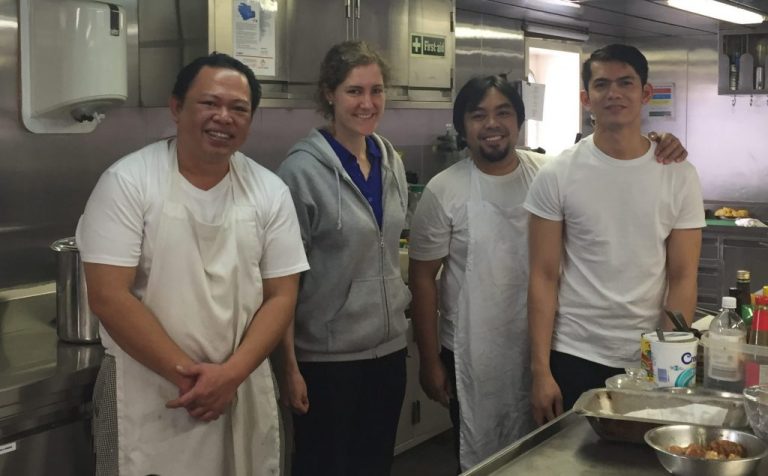
Karen with the galley crew onboard the Australian Spirit
Karen Campbell, a current a naval architecture and marine engineering (M.Eng.) student, recently had the opportunity to go onboard one of Teekay’s conventional crude vessels, the MT Australian Spirit. Over the course of 13 days, she had a front seat view at a vessel in action once it left the shipyard – and also got a glimpse into what life is like at sea. She has written a series of blog posts about her experience, the first of which is below. We hope you follow along as she talks about touring the ballast tanks, mealtimes, work-life balance, community and family onboard, social activities, living on a tanker, and being in the bridge while sailing into port.
Hi, I’m Karen and I like boats. I’m also a mechanical engineer, and am currently studying naval architecture and marine engineering as an M.Eng. student at the University of British Columbia. I’ve also learned over the years that hands-on experience is super useful as an engineer (plus it’s almost always fun), so when the opportunity came up, I jumped at the chance of being the first student for a pilot program between Teekay and UBC.
Teekay already supports the UBC Naval Architecture and Marine Engineering (NAME) program in other aspects, but this new partnership presents a unique opportunity for new professionals in our field. Naval architects learn the theory behind the design and construction of ships, but having a practical feel for how ships are operated and how they perform is both hard to teach in classroom and invaluable when it comes to making real-life design choices. This program gives students a rare opportunity to sail aboard a working vessel and develop some of that ‘gut feeling’ for how a ship really works.
My learning experience started before I got anywhere near the ship. I was warned from the beginning that nothing was 100% certain until I set foot on the vessel, and not necessarily even then. My first practical lesson was to realize the truth in that warning. I heard about the opportunity maybe two months before it happened. The plane ticket to Newfoundland was booked the day before I left. The return plane ride was booked while I was somewhere out on the Atlantic on the return trip to Newfoundland. I also learned how much I appreciate plans, as well as helpful and encouraging people for when plans are difficult to make!
As I discovered the stressful way, crude carriers’ schedules are not nearly as driven by tight timelines as cruise ships or even container ships. Instead, they tend to be slower overall and more flexible to accommodate shifts in supply and demand of the crude. Being able to be flexible regarding when processes like bunkering or offloading occur also represents a way to keep costs down. And even if all those factors could be planned to a tee, weather and sea conditions would certainly get in the way of achieving a perfect schedule!
Once the stressful business of getting to the ship was over, my education started in earnest. I spent the next 13 days trying to absorb as much as I possibly could. The engineer geek in me was in heaven – getting to see the guts and bones of a ship at work was amazing. But it was also fascinating to understand a little more about the business of shipping crude, and even more interesting to learn about life at sea and the men (and women) who chose to spend their time on a floating hunk of steel.
Overall, I’m glad to report that the worries I had going into the experience were unfounded, and the steps I took outside of my comfort zone were 110% worth it.
I hope you can follow along over the next few weeks as I share with you stories about my experience onboard the Australian Spirit.
Original story: Student’s Perspective
To read more about Karen’s experience, read her next blog post here.